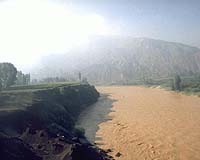| . |  |
. |
Chapel Hill NC (SPX) May 20, 2009 Excess phosphorus and nitrogen produced by human activities on neighboring land is making its way into our coastal waters and degrading both water quality and aquatic life. Although historically the priority has been to control phosphorus, Professor Hans Paerl, from the University of North Carolina in the US, argues that nitrogen imbalance is equally damaging. He adds that a dual nutrient strategy - tackling both phosphorus and nitrogen surplus - is necessary to manage effectively this nutrient over-enrichment and resulting habitat degradation of coastal waters in the long-term. His perspective1 is published online in Springer's journal Estuaries and Coasts. The combination of human population growth, urbanization, and agricultural and industrial expansion is causing unprecedented and alarming rates of nutrient over-enrichment and accelerated plant growth in receiving waters worldwide. The increasing levels of nitrogen and phosphorus are of particular concern because an excess of these two nutrients promotes accelerated production of plant-based organic matter (or eutrophication) to the extent that excessive production, including harmful algal blooms, contributes to the expansion of marine 'dead zones' and leads to the destruction of fisheries habitat. The negative consequences of eutrophication have been apparent in freshwater habitats for a long time and phosphorus has been identified as the key nutrient responsible. While freshwater lakes have, over the past few decades, received continual doses of phosphorus, many coastal systems have experienced ever-increasing nitrogen loads from rapidly growing human sources, with severe negative impacts on ecosystem structure and function. This has led to the need for nitrogen control measures. Professor Paerl shows that the argument for reducing surplus phosphorus alone, to control eutrophication, is idealized and conceptually and technically inapplicable to many freshwater and marine ecosystems. He adds that focusing on phosphorus alone ignores the fact that natural and human influences that affect upstream waters have significant adverse consequences on downstream waters. Therefore, it is essential to look at nutrient control measures and their effects across the entire freshwater to marine continuum, not each one in isolation. Professor Paerl concludes that "the dual nutrient approach represents an evolutionary step in arresting eutrophication, with consideration of the larger scale freshwater-marine continuum being the driving force. Only focusing on a stream, lake, or river within this hydrologic continuum may at best only solve part of the larger scale eutrophication problem and at worst aggravate downstream ecological conditions." Share This Article With Planet Earth
Related Links University of North Carolina Water News - Science, Technology and Politics
 Global Action Urged To Preserve Water Supplies For Billions Worldwide
Global Action Urged To Preserve Water Supplies For Billions WorldwideLaJolla CA (SPX) May 18, 2009 Melting glaciers, weakening monsoon rains, less mountain snowpack and other effects of a warmer climate will lead to significant disruptions in the supply of water to highly populated regions of the world, especially near the Himalayas in Asia and the Sierra Nevada Mountains of the western United States, according to an international group of scientists who met for three days at the University ... read more |
|
| The content herein, unless otherwise known to be public domain, are Copyright 1995-2009 - SpaceDaily. AFP and UPI Wire Stories are copyright Agence France-Presse and United Press International. ESA Portal Reports are copyright European Space Agency. All NASA sourced material is public domain. Additional copyrights may apply in whole or part to other bona fide parties. Advertising does not imply endorsement,agreement or approval of any opinions, statements or information provided by SpaceDaily on any Web page published or hosted by SpaceDaily. Privacy Statement |